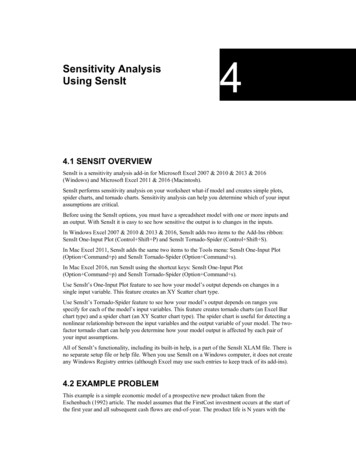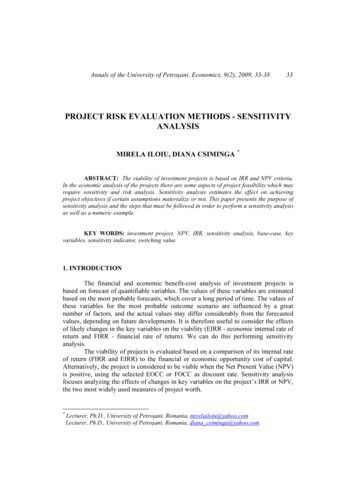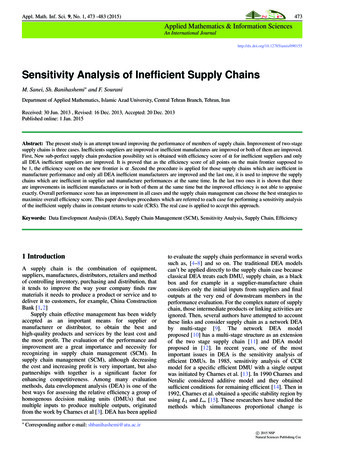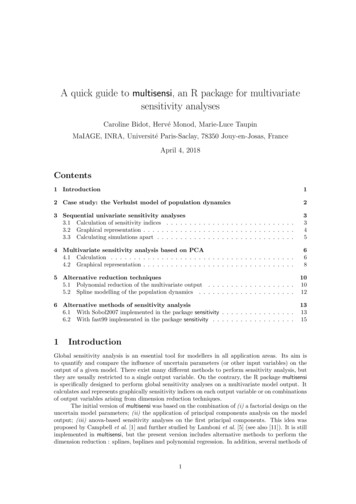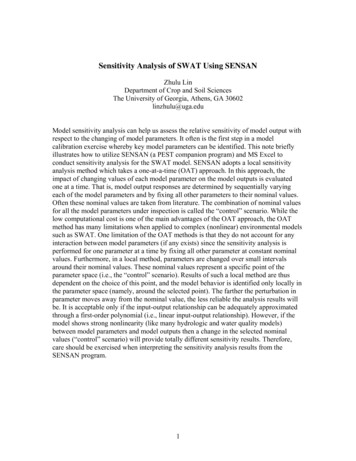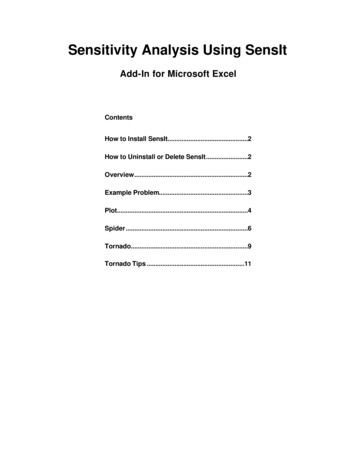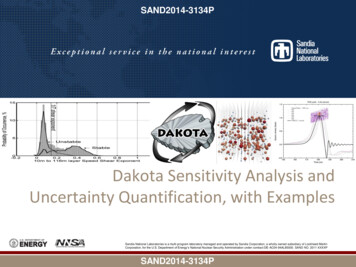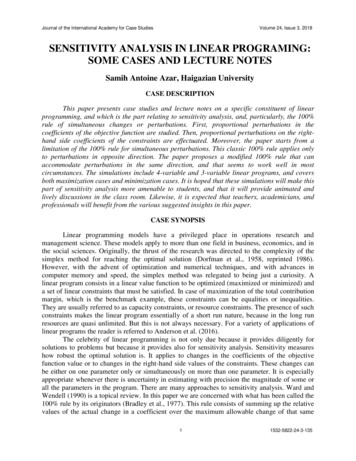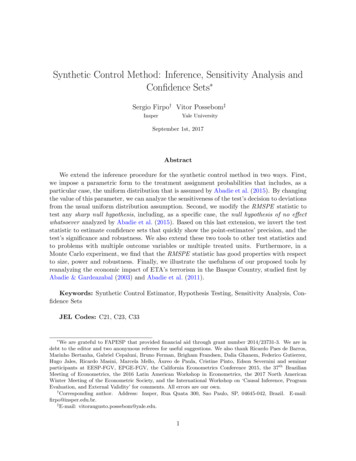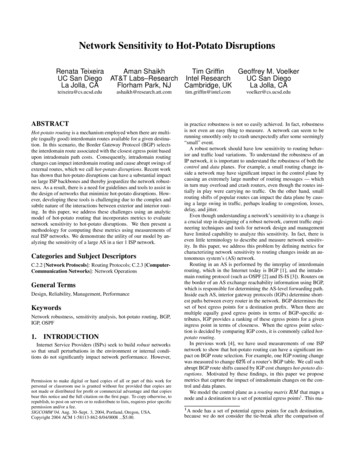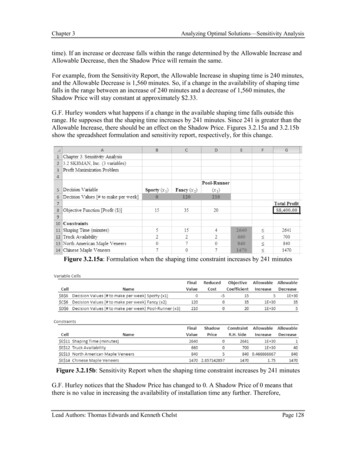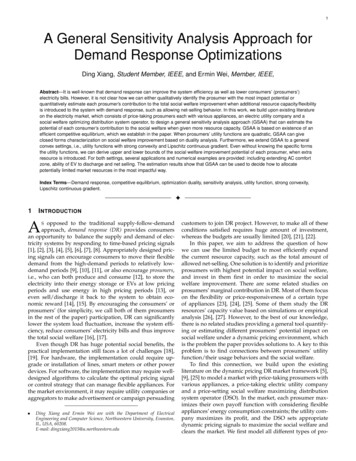
Transcription
1A General Sensitivity Analysis Approach forDemand Response OptimizationsDing Xiang, Student Member, IEEE, and Ermin Wei, Member, IEEE,Abstract—It is well-known that demand response can improve the system efficiency as well as lower consumers’ (prosumers’)electricity bills. However, it is not clear how we can either qualitatively identify the prosumer with the most impact potential orquantitatively estimate each prosumer’s contribution to the total social welfare improvement when additional resource capacity/flexibilityis introduced to the system with demand response, such as allowing net-selling behavior. In this work, we build upon existing literatureon the electricity market, which consists of price-taking prosumers each with various appliances, an electric utility company and asocial welfare optimizing distribution system operator, to design a general sensitivity analysis approach (GSAA) that can estimate thepotential of each consumer’s contribution to the social welfare when given more resource capacity. GSAA is based on existence of anefficient competitive equilibrium, which we establish in the paper. When prosumers’ utility functions are quadratic, GSAA can giveclosed forms characterization on social welfare improvement based on duality analysis. Furthermore, we extend GSAA to a generalconvex settings, i.e., utility functions with strong convexity and Lipschitz continuous gradient. Even without knowing the specific formsthe utility functions, we can derive upper and lower bounds of the social welfare improvement potential of each prosumer, when extraresource is introduced. For both settings, several applications and numerical examples are provided: including extending AC comfortzone, ability of EV to discharge and net selling. The estimation results show that GSAA can be used to decide how to allocatepotentially limited market resources in the most impactful way.Index Terms—Demand response, competitive equilibrium, optimization duality, sensitivity analysis, utility function, strong convexity,Lipschitz continuous gradient.F1I NTRODUCTIONAS opposed to the traditional supply-follow-demandapproach, demand response (DR) provides consumersan opportunity to balance the supply and demand of electricity systems by responding to time-based pricing signals[1], [2], [3], [4], [5], [6], [7], [8]. Appropriately designed pricing signals can encourage consumers to move their flexibledemand from the high-demand periods to relatively lowdemand periods [9], [10], [11], or also encourage prosumers,i.e., who can both produce and consume [12], to store theelectricity into their energy storage or EVs at low pricingperiods and use energy in high pricing periods [13], oreven sell/discharge it back to the system to obtain economic reward [14], [15]. By encouraging the consumers’ orprosumers’ (for simplicity, we call both of them prosumersin the rest of the paper) participation, DR can significantlylower the system load fluctuation, increase the system efficiency, reduce consumers’ electricity bills and thus improvethe total social welfare [16], [17].Even though DR has huge potential social benefits, thepractical implementation still faces a lot of challenges [18],[19]. For hardware, the implementation could require upgrade or installation of lines, smart meters or other powerdevices. For software, the implementation may require welldesigned algorithms to calculate the optimal pricing signalor control strategy that can manage flexible appliances. Forthe market environment, it may require utility companies oraggregators to make advertisement or campaign persuading Ding Xiang and Ermin Wei are with the Department of ElectricalEngineering and Computer Science, Northwestern University, Evanston,IL, USA, 60208.E-mail: dingxiang2015@u.northwestern.educustomers to join DR project. However, to make all of theseconditions satisfied requires huge amount of investment,whereas the budgets are usually limited [20], [21], [22].In this paper, we aim to address the question of howwe can use the limited budget to most efficiently expandthe current resource capacity, such as the total amount ofallowed net-selling. One solution is to identify and prioritizeprosumers with highest potential impact on social welfare,and invest in them first in order to maximize the socialwelfare improvement. There are some related studies onprosumers’ marginal contribution in DR. Most of them focuson the flexibility or price-responsiveness of a certain typeof appliances [23], [24], [25]. Some of them study the DRresources’ capacity value based on simulations or empiricalanalysis [26], [27]. However, to the best of our knowledge,there is no related studies providing a general tool quantifying or estimating different prosumers’ potential impact onsocial welfare under a dynamic pricing environment, whichis the problem the paper provides solutions to. A key to thisproblem is to find connections between prosumers’ utilityfunction/their usage behaviors and the social welfare.To find this connection, we build upon the existingliterature on the dynamic pricing DR market framework [5],[9], [25] to model a market with price-taking prosumers withvarious appliances, a price-taking electric utility companyand a price-setting social welfare maximizing distributionsystem operator (DSO). In the market, each prosumer maximizes their own payoff function with considering flexibleappliances’ energy consumption constraints; the utility company maximizes its profit, and the DSO sets appropriatedynamic pricing signals to maximize the social welfare andclears the market. We first model all different types of pro-
2sumers’ constraints by a general linear constraint. Then weshow there exists an efficient competitive equilibrium andan equivalence relationship between DSO’s problem and theprosumers’ and the utility company’s problems. Based onthe general linear constraint and the equivalence relationship, we propose a general sensitivity analysis approach(GSAA) to quantify the effect of prosumers’ contributionon social welfare when more resource is injected into thesystem, modeled by enlarging their constraint sets.Since each prosumer’s usage behavior is highly relatedto their own preference, which is commonly modeled bya (net) utility function [9], [12], [25], [28], [29], the characteristics of different types of utility functions could affectthe connection between prosumers’ usage behaviors and thesocial welfare, thus could also change the way we quantifyor estimate each prosumer’s contribution on social welfare.In this work, we consider two types of (net) utility functionsettings, quadratic function, which is commonly used inmany DR related papers [9], [25], [28], [29] and generalconvex function (i.e., strongly convex and with Lipschitzcontinuous gradient), which is more general and captures avariety of functions.As the main contributions of this paper, we relate thepotential social welfare improvement and individual prosumer by duality theory and use the proposed GSAA tocharacterize the shadow prices associated with more resources in the system, i.e., a larger constraint set. Whenthe net utility functions have quadratic forms, we derivethe shadow prices explicitly and when the utility functionshave general convex form, we establish the bounds ofthe shadow prices. Under different utility settings, severalapplications of GSAA are provided, including enlarging aprosumer’s AC comfort zone size, allowing a prosumer’sEV to discharge and allowing a prosumer to net sell. Theestimation can be used to identify the prosumers with themost potential impact on social welfare. Thus, when thebudgets for implementing DR are limited, we could allocatethem to those prosumers accordingly. We also provide acase study in the general convex settings to compare 2prosumers’ contribution potentials for allowing them todischarge EVs. The two prosumers are identical, except thatone’s net utility function is the other’s scaled by a constant.We would expect the one with a larger utility function tohave a higher contribution potential, but to our surprise, thebounds of the shadow price given by GSAA show otherwiseunder certain conditions. Lastly, several numerical studiesabout the usage of GSAA in net-selling and EV dischargingare provided.The rest of the paper is organized as follows. In Section2, we introduce the system model and the general linearconstraint. In Section 3, we prove the existence of theefficient market equilibrium and the equivalence betweenDSO problem and prosumers’ and the utility companies’problems, which form the foundation of GSAA. Section4 studies the usage of GSAA under quadratic net utilityfunction settings, where the closed-form shadow price arecalculated and Section 5 talks about the usage of GSAAunder the general convex settings in which the bounds ofthe shadow price are derived. In Sections 6, we providenumerical studies to illustrate the usage of GSAA.Notations: Throughout the paper, we use bold font to rep-resent vectors variables, and superscript H for transpose.TNotation (xi , i) denotes vector [x1 , x2 , ., xn ] . For column vectors x1 , x2 , ., xn , we use notation (xi , i) to denote Ta combined column vector xT1 , xT2 , ., xTn . For a vectorTx [x1 , x2 , ., xn ] , we denote the j th element of x as[x]j .The operator [·] is given by [a] max{a, 0}. Weuse k · k to denote that Euclidean norm or L2 norm. Fora matrix A, we denote its element on the ith row and thej th column as [A]ij . Inequalities, , , , are used in anelement-wise sense. The notation diag{A} denotes a columnvector consists of the diagonal elements of matrix A. WeA 0use notation diag (A, B) to denote matrix. For a0 Bnfunction f (x1 , x2 , ., xn ) : R R, f is the gradient of f , f T fand f ( x, f , ., x) .1 x2n2S YSTEM M ODELIn this section, we introduce our general market modelconsisting of three participants: prosumers, an electric utilitycompany and a DSO. We use N {0, 1, 2, ., N } to denotethe set of all nodes in the power network. Without lossof generality, we let node 0 represent the electric utilitycompany and the nodes in N {1, 2, ., N } representindividual prosumers. In rest of the paper, the words ‘prosumer node’ and ‘prosumer’ are used interchangeably. Similarly, we do not distinguish between the words ‘electricutility company node’, ‘electric utility company’ or ‘utilitycompany’ unless otherwise noted. The DSO, as a socialplanner and a system operator, maximizes the social welfarewhile clearing the market and guarantees system operationreliability. The market we consider here is a retail electricitymarket with no uncertainty and H periods, indexed byt H {1, 2, ., H}. We assume in this market bothprosumers and the electric utility company are price-taking.We call the market H -period DR market.For each prosumer i N , let Ai denote the set ofhousehold appliances, such as lights, air conditioners (ACs),washers, energy storage and electric vehicles (EVs). For eachappliance a Ai , we define its power consumption scheduling Dvector as qD q(t), tin RH where qi,a (t) Ri,ai,arepresents the power consumption of prosumer i’s appliance a at time t, and superscript D indicates the demandside (i.e., the prosumers). We can concatenatethesevectors D Dto define for each prosumer i, qi qi,a , a in RH Ai and thePaggregate vector for all prosumers, qD qDi , iin RH i N Ai . For the utility company (superscript Srepresenting the supply side), we define its power supply scheduling vector as qS , where qS q S (t) , t in RH .At last, we define the market clearing electricity price vector, which is announced by DSO, as p (p (t) , t) in RH .2.1Prosumer ModelIn our model, prosumers (i.e., users who can both buy andsell back electricity) optimize their power schedules to maximize their own payoffs. Here the payoffDfunction P is definedT Dby a quasilinear function Ui qD Cqia Ai p qi,a ,ii which includes a utility function Ui : RH Ai R thatreflects prosumer i’s preference on energy consumption for
3appliances, a cost function Ci : RH Ai R representingamortized battery life loss for EVs and energy storage(forappliances, Ci 0), and payments P otherT non-batteryDDpq.ThecombinationtermsUq Ci qDia Aii,aiiare also called net utility function. With these components,the prosumers’ problem (P) is formulated as follows. Foreach prosumer i N X CqDpT qD(P1)max Ui qDiii,a ,iqDis.t.a AiAi qDi hi ,(P2)We adopt the following simplifying assumption:Assumption 1. Prosumer i’s utility function Ui (qDi ) and costfunction Ci ng the above assumption, prosumer i’s utility function and cost function can be written asX XtDUi (qDUi,a(qi,a(t)),(1)i ) a Ai t HCi (qDi ) X XtDCi,a(qi,a(t)),(2)a Ai t Htwhere Ui,a: R R is the utility function for appliance a atttime t and Ci,a: R R is the cost function for appliance aat time t, and we adopt the following standard assumptionsttfor functions Ui,aand Ci,a:tDtDAssumption 2. Functions Ui,a(qi,a(t)) and Ci,a(qi,a(t))are convex non-decreasing and differentiable in their respectiveeffective domains. The gradient of the net utility function at 0 iselement-wise positive, i.e. Ui (0) Ci (0) 0.We note that, in the prosumer model (P), there is nosign restriction on qDi,a , meaning that the prosumers caneither consume or produce/sell electricity (hence the nameprosumer).The set of linear inequalities Ai qDi hi includes representations of different power consumption requirements forhousehold appliances of prosumer i. Particularly, for all theappliances, we divide them into two types based on theirflexibility: flexible appliances and inflexible appliances.For flexible appliances such as ACs, washers, dryers, dishwashers, fridges, EVs/PHEVs and energy storage,whose power consumption may change depending on theprice, their constraints (P2) can be written as the followingforms based on [9], [5] and [30].DDDqi,a(t) q D t,(3)i,a (t) , qi,a (t) q i,a (t)XXDDDαi,a (t) qi,a(t) Qi,a ,αi,a (t) qi,a(t) QD,i,at Hi,at Hi,a(4)where constraint (3) represents an available range of thepower consumption for the flexible appliance at time periodt. For AC, it means the power should between 0 and therated power; for EV/PHEV and energy storage, it means thepower should be between maximal discharging power andmaximal charging power. Note that the power lower boundqD(t) could be negative for EVs, PHEVs and energy stori,aage, which reflects the definition of prosumer. Constraint(4) indicates an acceptable energy consumption range of theflexible appliance during the pre-specified periods of timeHi,a H.1 We call these periods in total a flexible period,during which the appliance can adjust its power scheduleas long as it can finish certain task within certain energyusage limit. For example, AC consumes enough (but nottoo much) energy to maintain the room temperature [9],[30] in a comfortable level during the hottest time of dayin summer, a washer finishes laundry by a specified timeset by its user, an EV owner charges/discharges his/hercar at home overnight for a trip the next day, or energystorage keeps its battery level within certain range to ensurea longer battery life. The coefficient αi,a (t) in constraint (4)is used to capture efficiency (in a broad sense) of differenttypes of flexible appliances. For most appliances such aswashers, EVs and storage, αi,a (t) is a power loss factor inan energy transmission process. In an ideal case, αi,a (t) isset to constant 1, meaning there’s no loss in the process.For AC, coefficient αi,a (t) has a more special meaning,which describes time dynamic relationships between roomtemperature and AC power schedules.For inflexible appliances such as lights, routers, monitorcameras, computers, TVs etc., their power consumptionconstraints can be written as the form of inequalities (3)(without (4)), i.e., the power consumption in each periodis in a certain range.In addition to representing the appliance power consumption requirements, the constraint Ai qD hi alsoidescribes prosumer i’s type of usage behavior, which canbe divided into three types: simple buyers, net buyers andnet sellers. The simple buyers are users who only consumeenergy, but do not discharge energy back to grid (for theirown usage or selling to others). Their DR constraints canbe described by (3)-(4) with q D(t) 0, which implies thati,aDtheir qi,a(t) is non-negative. The net buyers are users whocan consume energy, store energy and discharge for theirown usage but cannot sell to others. Their DR constraintscan be described by (3)-(4) and the following constraint:XDqi,a(t) 0, t.(5)a AiLastly, the net sellers are those who can consume, store andsell energy to others. Their DR constraints can be coveredby (3) and (4) only. To avoid trivial cases, we make thefollowing assumption:Assumption 3. In the problem (P), the feasible set is nonempty.2.2Electric Utility Company ModelThe electric utility company maximizes its profit (equalto revenue minus cost) by optimizing its power supplyscheduling qS . Hence, the electric utility company’s problem (U) is formulated by max pT qS C0 qS ,(U)qSwhere C0 : RH R is the cost function and assumed tobe convex and continuously differentiable in its effective1. If an appliance has multiple flexible periods in H, then the appliance has multiple constraints in form (4). For the detailed models ofappliances, interested readers are referred to [9] and [30].
4domain. To avoid trivial cases, we make the followingassumption:Assumption 4. In problem (U), there exists at least one globaloptimal solution.2.3Distribution System Operator ModelDistribution system operator is a benevolent system planner, which maximizes the social welfare as well as keeps thesupply-demand balance. The problem DSO solves, referredto as (D), is given below. max U qD C qD C0 qS ,(D1)qD ,qSAqD h,X XqS qDi,a ,s.t.(D2)(D3)i N a Aiwhere the objectiveP function in (D1) is the social welfare.Function U : RH i N Ai R Pis prosumers’ total utilityDfunction,Pdefined by U (qD ) i N Ui (qi ). Similarly,H i N Ai C : R PR is prosumers’ total cost function,Ddefined by C(qD ) i N Ci (qDi ). We know that U (q )Dand C(q ) are concave and convex respectively due toAssumption 2.The constraint AqD h in (D2) is an aggregation of theconstraint (P2), Ai qDi hi , for all prosumers. Specifically, A diag(A,A,.,AN ), qD qDand h 1 2i , i N hD.i , i NWe call the j th constraint for prosumer i in (D2) (i.e., thethj th row of Ai qDgeneral linear constraint fori hi ) as the jprosumer i, which can be written as the following,X X (j)Dαi,a (t) qi,a(t) [hi ]j ,(6)(j)a Ai(j)(j)t Hi,a(j)where Ai Ai and Hi,a H. We note that constraint(6) covers all individual constraints (i.e., (3)-(5)) appearedin (D2) and gives each individual constraint a unique label.When Eq. (6) represents (3) or (4), the value [hi ]j specifiesavailable ranges of power consumption for prosumer i’s appliances. When Eq. (6) represents (5), [hi ]j restricts prosumeri’s net-selling amounts. In either case, [hi ]j reflects prosumeri’s capacity of resources in DR. For generality, we call each[hi ]j as a Resource Capacity (RC) for prosumer i.The constraint (D3) is the supply and demand balanceequation. We refer to this as the market clearing condition. Wecall the dual variable associated with the constraint (D3) asthe market clearing price.3E FFICIENT M ARKET E QUILIBRIUMWe first introduce basic definitions used in this section.The main goal of this section is to show that in theproposed H -period DR market, there exists a competitiveequilibrium with an efficient allocation, and the competitive equilibrium set is equivalent2 to the set of efficientallocations and the corresponding market clearing prices. Inparticular, it is described by the following theorem, whosestatement partially appeared in our previous conferencepaper [31]. Here we provide the complete version and itsdetailed proof.Theorem 3.1. In the proposed H -period DR market, (1) thereD Sand a priceexists an efficient demand-supplyallocationq,q D Svector p such thatq,q,pformsacompetitiveequilibrium; D S (2) set V1 q , q , p : qD , qS , p is a competitive equilibrium , is equivalent to set V2 qD , qS , p : qD , qSis an efficient allocation and p is its market clearing price .Proof. (1) We prove Theorem 3.1 (1) by construction. First,based on Assumptions 1-3, we know problem (D)’s objectivefunction is continuous and concave, and its feasible setgiven by (D2) and (D3) is convex, nonempty and compact. By Weierstrass extreme value theorem,there exists a bounded optimal solution qD , qS . Then the optimalobjective value of (D) is finite. Also due to linear forms of(3)-(5) and (D3), we know problem (D) has affine constraints.Hence, by Proposition 5.3.1 on existence of primal anddual optimal solutions in [32], the dual optimal solutionfor problem (D) exists. Let (λ , ρ ) denote a dual optimalsolution pair to problem (D), where vectors λ and ρ are Lagrange multipliers for the constraints (D2) and (D3)respectively. Then the following Karush-Kuhn-Tucker (KKT)conditions hold:Ai qD hi 0, i N ,iX XqD qS i,a ,(PF1)(PF2)i N a Ai λ i 0, i N ,(DF) T diag λ i Ai qD hi 0, i N ,(CS)i U CqD qD AT λ ν 0, (FOC1) D q qD C0 S q ρ 0,(FOC2) qSwhere vector λ i is the Lagrange multiplier that associated with prosumer i’s constraints in (D2), thus wehave λ (λ i , i N ). Vector ν is given by ν T T TPρ , ρ , ., ρ Twith ρ T repeated i N Ai times.In the above KKT conditions, constraints (PF1) and (PF2)describe primal feasibility, inequalities in (DF) reflect dualfeasibility, equations in (CS) are complimentary slacknessconditions, and equations (FOC1) and (FOC2) are first orderoptimality conditions. When DSO sets the market price to C0 S p ρ q, qSDefinition 1 (Competitive Equilibrium). A competitive equilibrium is defined by a demand-supply allocation and a pricevector in a market such that all agents’ (prosumers’ and the utilitycompany’s) choices are individually optimal (for problems (P) and(U)) given the price, and the market clears.conditions (PF1), (DF), (CS) and (FOC1) guarantee qD i(selected from qD ) and λ i satisfy problem (P)’s KKT con-Definition 2 (Efficient Allocation). An allocation is efficient ifit solves optimization problem (D).2. We say set A is equivalent to set B , if there exists a 1-1 mapping ofset A onto set B.
5dition, as shown below T Ai qD hi 0, λ i 0, diag λ i Ai qD hi 0,ii Ui D Ci D ATi λ i pi 0,qiqi D qD qii T T Twhere pi p , p , ., pTwith pT repeated Ai times,and because the convex problem (P)’s strong duality holds,which is guaranteed by Assumption 3 (refer to discussionsof constraint qualifications in Section 5.2.3 of [33]), thequantity qD is also an optimal solution to problem (P).i Similarly, the quantity qS in qD , qS is also anoptimal solution to problem (U), because condition (FOC2)guarantees qS satisfy problem (U)’s optimality condition,as shown below C0 S p 0.q qS Hence, the pair qD , qS , p form a competitive equilibrium. This completes the proof of (1).(2) We follow the same notation as in the first part. Forany competitive equilibrium qD , qS , p V1 , let λ (λ i , i N ), where λ i is the dual optimal solution toprosumer i’s problem (P) and let ρ p. Then we knowqD , qS and (λ , ρ ) satisfy problem (D)’s KKT conditions, since a combination of (P)’s KKT conditions, (U)’soptimality condition, the market clearing equation and theabove equations together forms problem (D)’s KKT conditions. By strong duality of problem (D) due to Assumption3, we have qD , qS and (λ , ρ ) are primal and dualD S optimal solutions to problem(D),thusq,q,p V2 . Conversly, if qD , qS , p V2 , then by the same processof proof of (1), weas long know as the DSO sets priceD S S*0,q,q,pbecomes a competitiveqto p CS q equilibrium, thus qD , qS , p V1 . This shows V1 V2 .Hence, we obtain V1 is equivalent to V2 .not be derived explicitly. Instead, we analyze properties ofthe bounds on the shadow price.4Q UADRATIC S ETTINGSIn this section, we consider a setting, where all the netutility functions (Ui Ci ) , i N are quadratic. ThenGSAA can provide a closed-form shadow price reflectingquantitative information about impacts of the general linearconstraints on the optimal objective value, i.e., maximalsocial welfare.4.1Model Reformulation in Quadratic SettingsIn the quadratic setting, the models of prosumers, the utilitycompany and DSO can be reformulated into the followingforms.4.1.1 ProsumerThe net utility function of prosumer i using appliance a attime t by consuming quantity x is given below,ttUi,a(x) Ci,a(x) âi,a (t) x2 b̂i,a (t) x ĉi,a (t) ,where the second order coefficient âi,a (t) 0 representsthe concavity of the appliance’s net utility. The first ordercoefficient b̂i,a (t) represents the appliance’s initial utilityincreasing rate, i.e., the utility associated with consumingthe first unit of energy. The constant ĉi,a (t) represents theinitial utility when time period t starts. For different typesof appliances, their quadratic net utility coefficients aredescribed in Table 1. More details on the coefficient meaningof different appliances can be found in [31].TABLE 1: Signs of Quadratic Net Utility CoefficientsInflexible AppliancesFlexibleThe above theorem is related to the fundamental theorems of welfare in economics [34], but they are differentbecause of the physical constraint (D2). From the theorem,we obtain an equivalence relationship between problem(D) and problems (P) and (U). This relationship makes itpossible for us, by only focusing on problem (D), to analyzesensitivity of prosumers’ contribution on social welfare inoptimal DR with the change of the resource capacity, [hi ]j .The analysis applies to many situations, such as the changeof AC comfort zone size, allowing prosumers to be netsellers and allowing EVs to discharge. For example, we cananalyze the effect of allowing an EV to discharge on theoptimal social welfare by changing the resource capacity[hi ]j of the EV’s discharging constraint. Since all individualconstraints can be described by the general linear constraint(6), we can perform the sensitivity analysis by analyzing thedual variable (shadow price) associated with the constraint(6) of problem (D). This is what we call General SensitivityAnalysis Approach, GSAA.In the following sections, we study GSAA in two different net utility function settings: quadratic and generalconvex. In the former case, the closed-form shadow pricecan be derived; while in the later case, the shadow price may(7)âi,a (t) 0, b̂i,a (t) 0, ĉi,a (t) 0ACs, Washersâi,a (t) 0, b̂i,a (t) 0EVs/PHEVsâi,a (t) 0, b̂i,a (t) 0, ĉi,a (t) 0Energy Storageâi,a (t) 0, b̂i,a (t) 0, ĉi,a (t) 0In the above table, in addition to ACs and washers,dryers, dishwashers and fridges also belong to the firstcategory under flexible appliances.With these quadratic coefficients, we can reformulateprosumer problem (P) into the following matrix form,1 D TT DTmaxqΛ i qDi (bi pi ) qi ci 1i , s.t. (P2),D2 iqi(8) where matrix Λi diag Λi,1 , Λi,2 , ., Λi, Ai with Λi,a diag (2âi,a (1) , 2âi,a (2) , ., 2âi,a (H))for a A i , vector bi (bi,a , a Ai ) with bi,a b̂i,a (t) , t H , vectorpi (p, a Ai ), vector ci (ci,a , a Ai ) with ci,a (ĉi,a (t) , t H), and vector 1i ((1, t H) , a Ai ).4.1.2 Electric Utility CompanyFor simplicity, we assume the utility company’s productioncost is linear and can be time-varying, i.e., for qS RH , C0 qS bT0 qS , where b0 RH(9) .
64.1.3DSOUnder the quadratic framework and by using equation (D3)to substitute decision variable qS with qD , the DSO problem (D) can be reformulated into the following quadraticprogramming problem,1 D TmaxΛ qD b̄T qD gT 1 s.t. (D2),(10)q2qDwhere matrix Λ diag (Λ1 , Λ2 , ., ΛN ), vectors b̄ ((bi,a b0 , a Ai ) , i N ), g (ci , i N ) and1 P (1i , i N )P. Matrix Λ is a full rank diagonalH i N Ai by H i N Ai matrix.4.2Shadow Price in Quadratic SettingsIn this section, we derive a closed-form expression of theshadow price, i.e., the Lagrange multiplier/the dual variable associated to the j th general linear constraint for prosumer i, (6), in the reformulated DSO problem (10). Let λdenote the Lagrange multiplier vector to constraint set (D2).First, we show an important property of the problem (10)used in deriving the shadow price later.Property 4.1. The reformulated DSO problem (10) is equivalentto the following N problems: i N ,1 D TT DTmaxqΛi qD(11)i b̄i qi ci 1i , s.t. (P2),2 iqDiwhere b̄i (bi,a b0 , a Ai ). By equivalent, we mean theyhave the same optimal primal solutions and the same optimal dualsolutions. (Problem (11) is the same as the reformulated prosumerproblems (8) with pi b0 , for all i N .)Proof. Notice that hthe objective function of problem(10)i TPDT DTΛq b̄q c1,whereis equal to i N 12 qDi ii ii iib̄i (bi,a b0 , a Ai ), and in (D2), the constraintscorresponding to one prosumer is independent from theconstraints corresponding to the other prosumers. Hence,the KKT conditions for the original problem (10) are thesame as the combination of KKT conditions of all decoupledproblems (11) (One can refer to the KKT conditions usedin Theorem 3.1’s proof). Hence, by strong duality of bothproblems (10) and (11) for all i N , their optimal primaland dual solutions are the same to each other.The above property tells us, deriving the shadow pricefor the DSO problem (10) is equivalent to deriving theshadow price for the decoupled problems (11). Furthermore,the
A General Sensitivity Analysis Approach for Demand Response Optimizations Ding Xiang, Student Member, IEEE, and Ermin Wei, Member, IEEE, Abstract—It is well-known that demand response can improve the system efficiency as well as lower consumers' (prosumers') electricity bills. However, it is not clear how we can either qualitatively .
